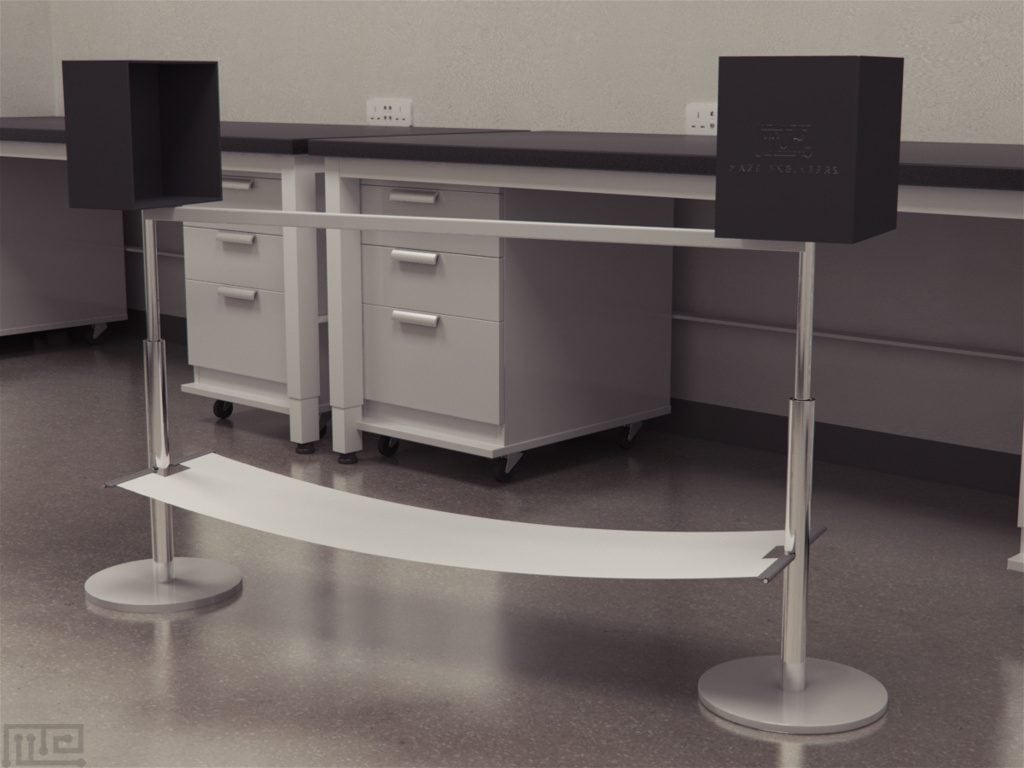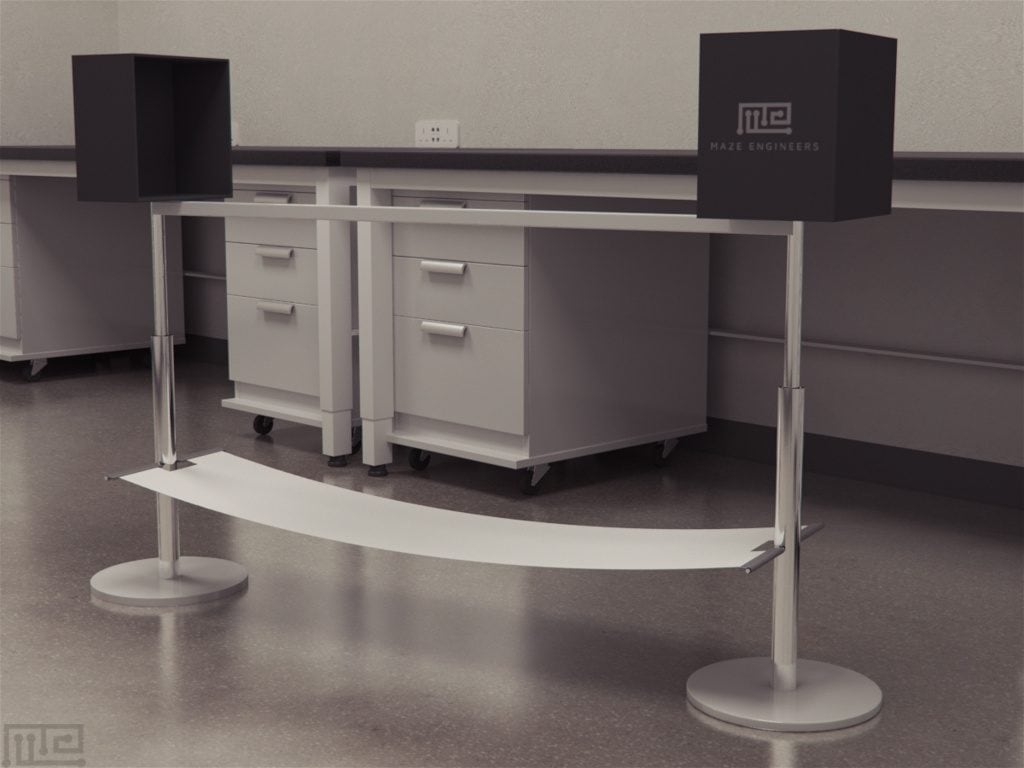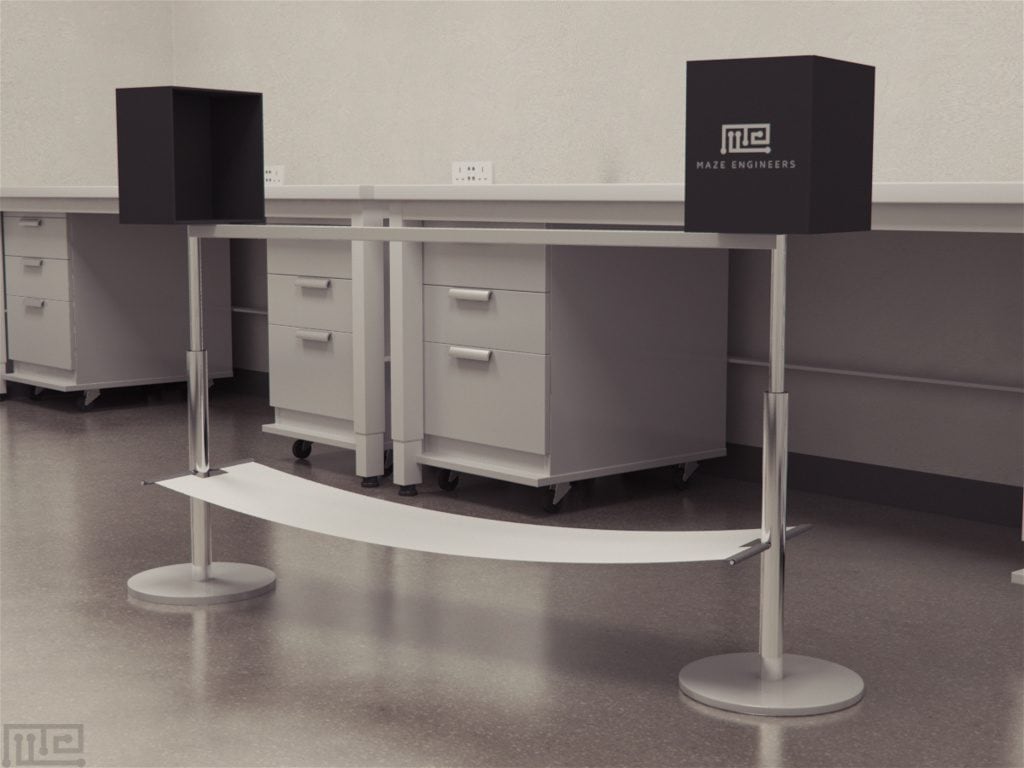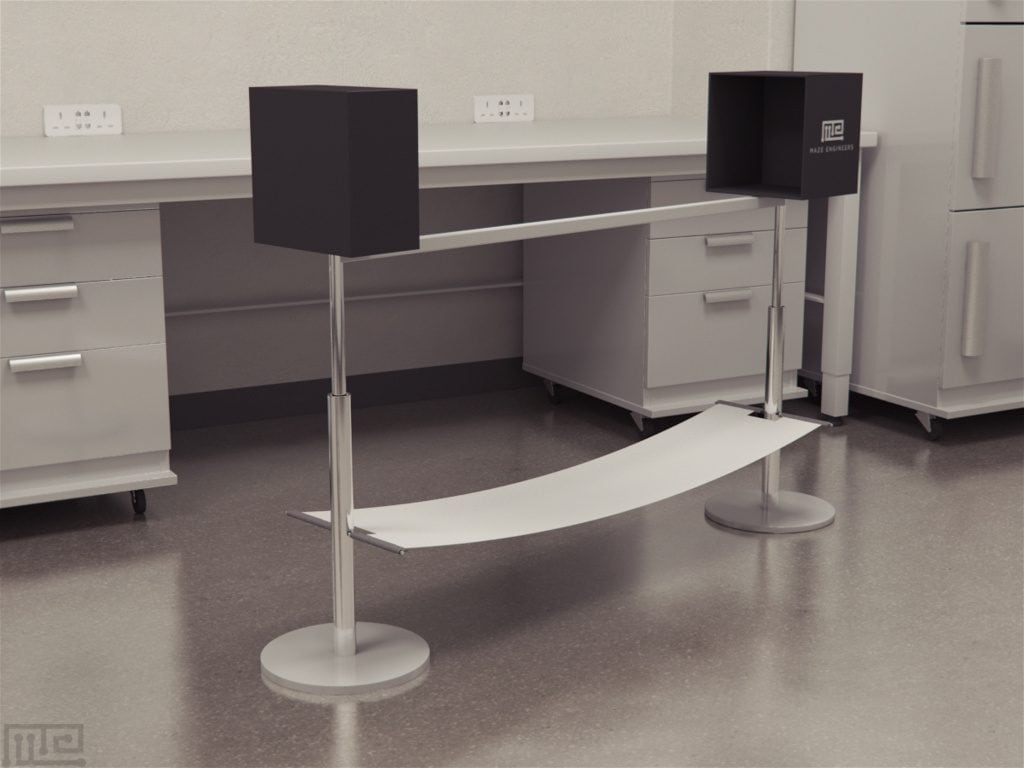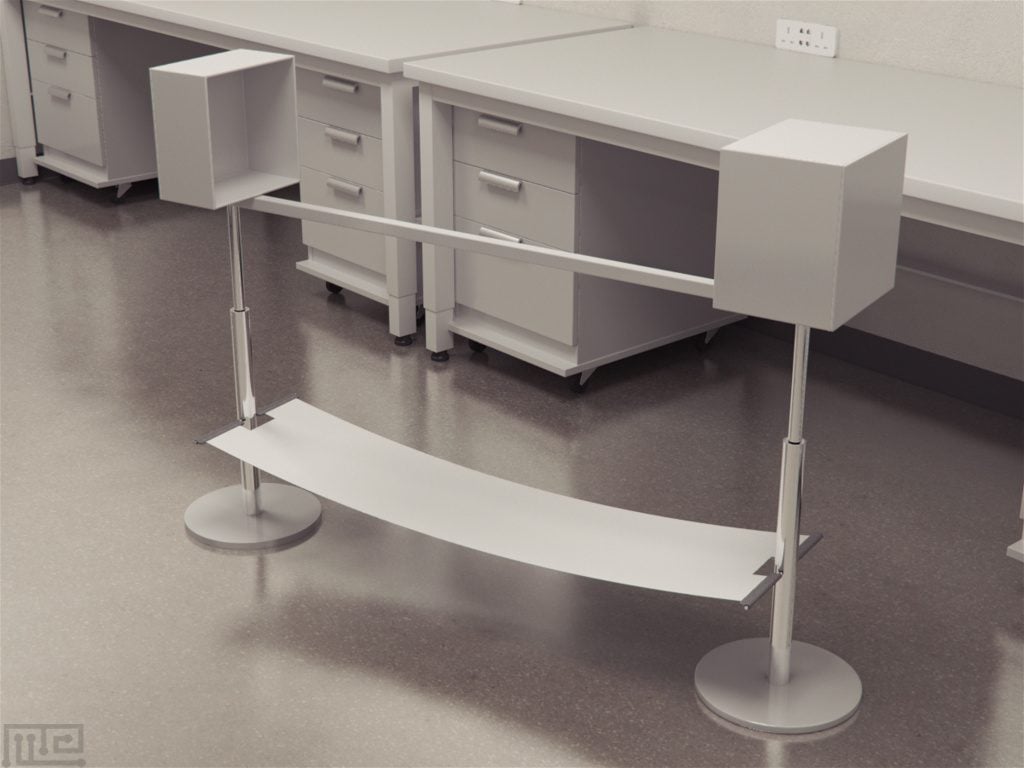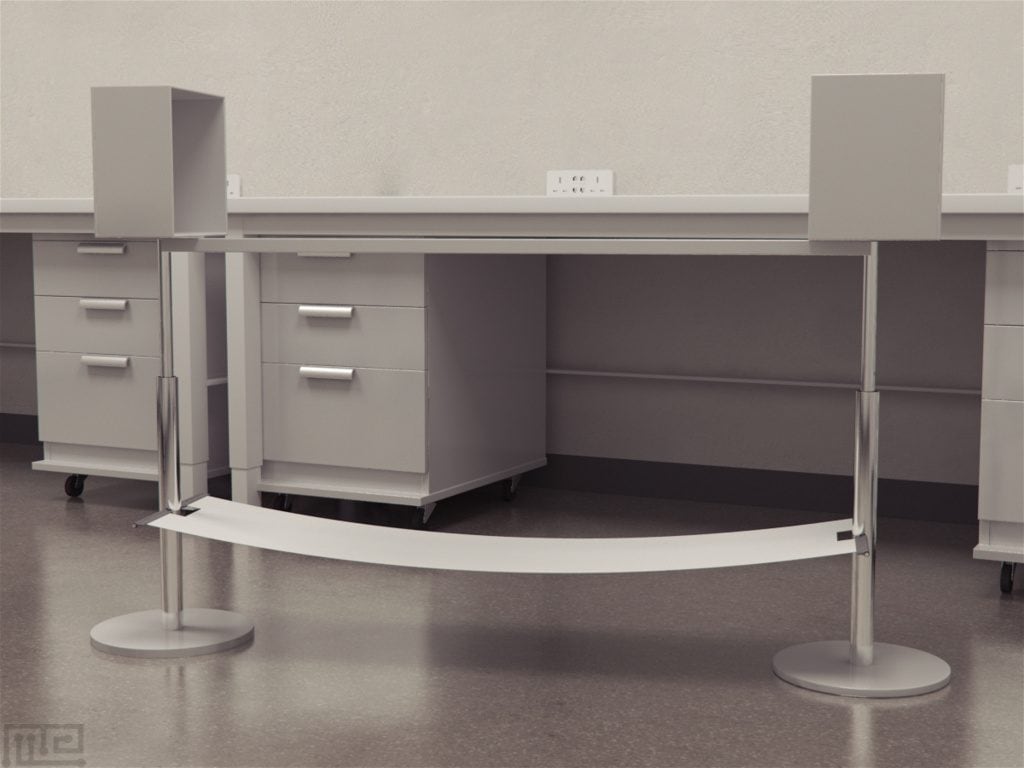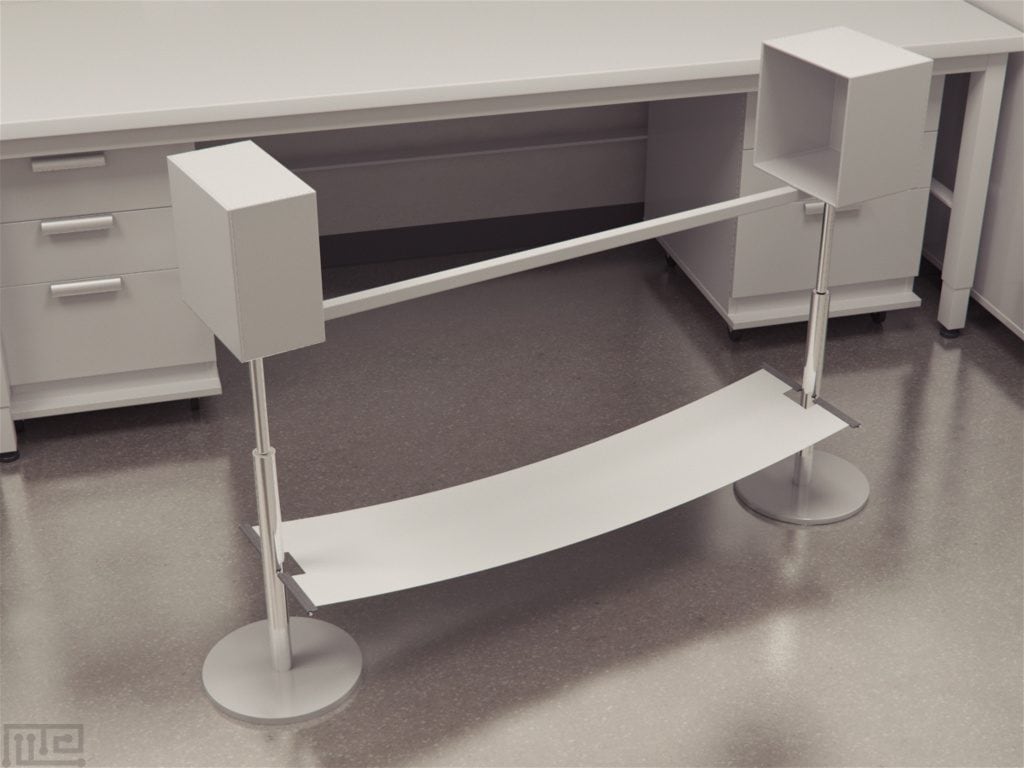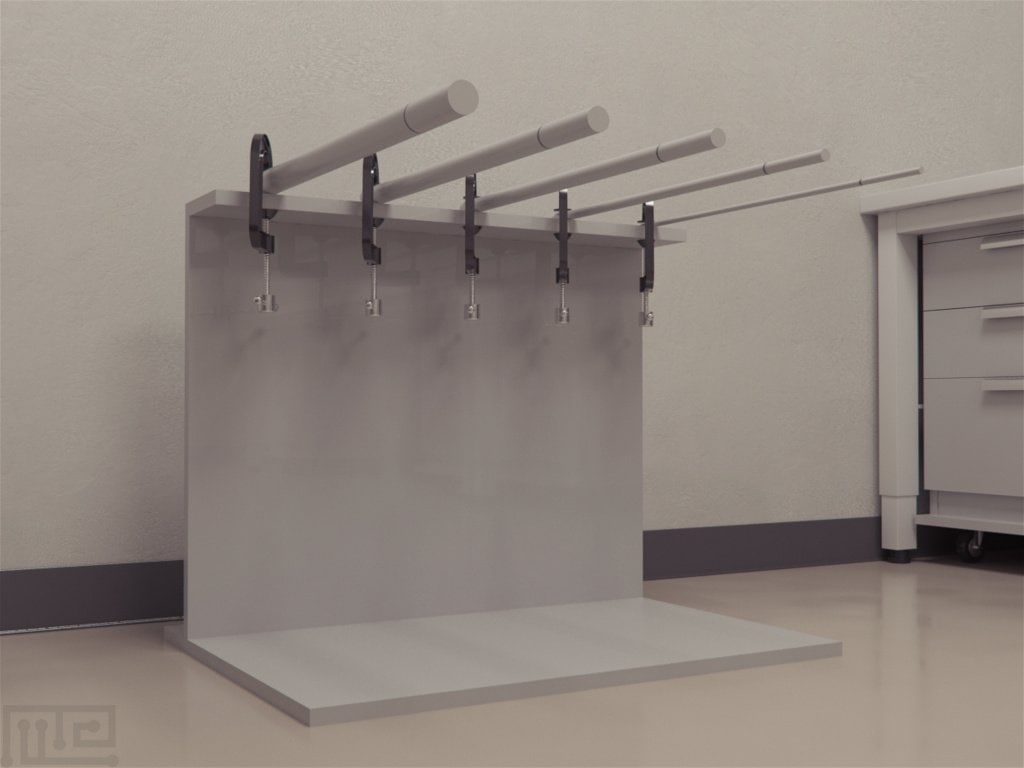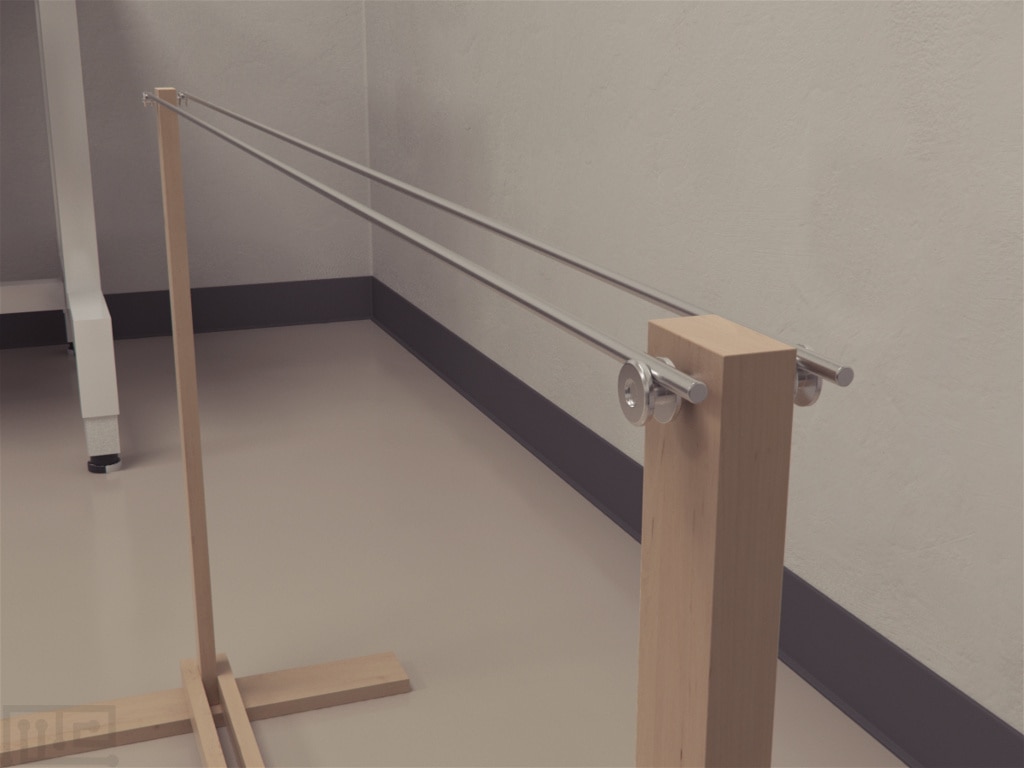
The Balance Beam apparatus is a narrow ‘walking bridge’ for mice / rats to walk across to test sensorineural balance and coordination. The beam generally sits between two elevated platforms with platforms to hold either mice or rats. Interchangeable beams can be used for thinner and thinner intervals.
The essential components include
- End platform
- Beams
- (Optional) Start Platform
- (Optional) Encatchment: A soft encatchment to prevent injury from falling
- Holes (~3mm diameter) along beam center to allow insertion of Protruding pegs
- Tapered Shape
- Second lower flat beam below main beam may be added to assist compromised animals. Detachable. Please inquire if needed.
- Convenient hinges along beam to allow flexible transport.
Other apparatuses used in assessing rodent motor function include the Grip Strength test, the Parallel Bars, the Geotaxis Test, the Static Rods Test, and the Gait Test, the Parallel Rod test, the Catalepsy Bar test, and the Pole test. See our activity range here.
Modifications
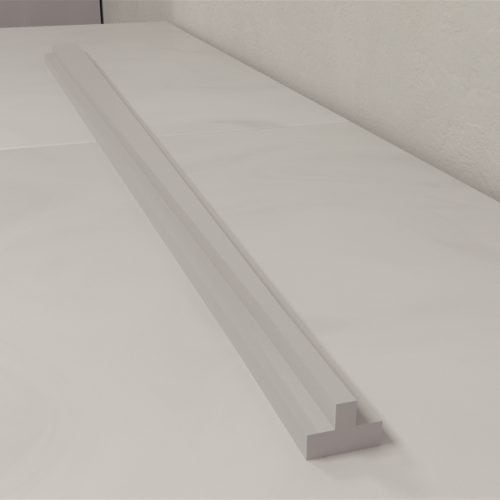
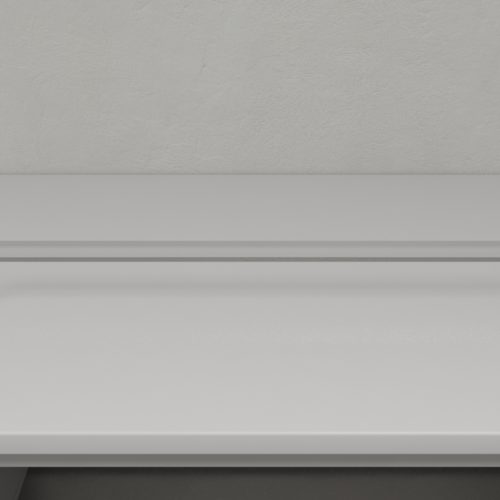
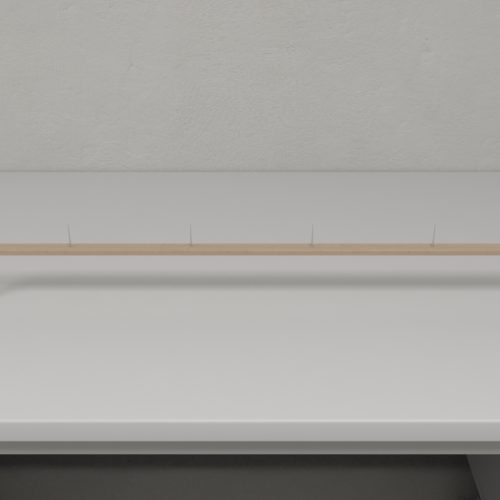
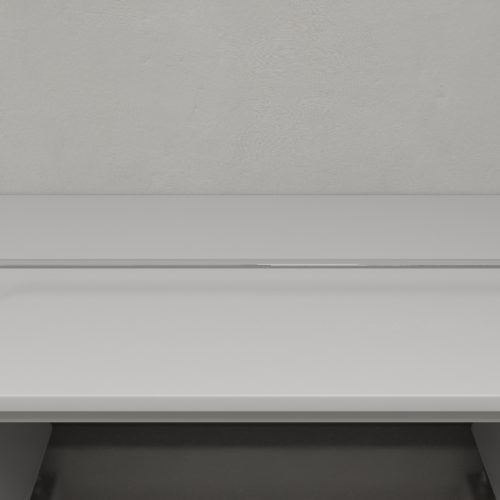
Prices and Sizes
Mouse
$ 1890
Beam + Stand- Length: 100cm
- Height: 50cm.
- End box: 20×20 x 20cm.
- Beam widths: 6,12, 24, 48mm. All widths are included in each order.
- Beam shape: Rectangular. Round beams are available upon request.
- (Optional) Start Platform ($300)
- (Optional) Encatchment: ($180)
- (Optional): Adjustable height, Angle (+$150)
Rat
$ 1990
Beam + Stand- Length: 125cm
- Height: 50cm
- End box: 25x25x25cm.
- Width of 6,12, 24, 48mm available. All widths are included in each order.
- Beam shape: Rectangular. Round beams are available upon request.
- (Optional) Start Platform + $350 (25cm x 25cm)
- (Optional)Encatchment +$210
- (Optional): Adjustable height, Angle (+$150)
Frequently Asked Questions
1. Can the Balance Beam apparatus be disassembled for long-term storage? Yes
2. Can the encatchment height be altered? (Higher or lower?) Yes
3. Can the beams’ height be altered? Yes
4. What is the total weight of the Beam Balance with encatchment? The shipping weight of the Balance Beam is 27lb
Documentation
Introduction
The balance beam is a test of motor coordination and balance in rodents. The test assesses sensorimotor function following motor cortex injury, traumatic brain injury, gamma-aminobutyric acid infusion into the frontal cortex and rodent models of stroke (reviewed by; Carter et al., 2001). In addition, this test can be used to evaluate the effects of aging and to characterize transgenic animals.
Rodent performance on the beam may improve with time after injury, with the use of drugs and with motor experience (Gentile et al., 1978, Feeney et al., 1982, Brailowsky et al., 1986). Amelioration of motor coordination after injury may be the result of a transient neural loss-of-function in areas remote from but connected to the area of injury.
The balance beam test requires the use of one or more narrow beams with varying dimensions and elevated from the ground. Avoidance stimuli should be used at the start of the beam. A goal box that serves as an escape from the stimuli should be placed at the opposite end. The trials should be video recorded.
Results can be presented as latency to traverse the beam, the number of foot slips and mean score if using a grading system (Feeney et al., 1982, Metz et al., 2000).
This test is widely used to assess fine motor deficits. It enables both short and long studies with multiple time points. Furthermore, it is inexpensive, methodologically unsophisticated and allows for substantial modifications of equipment and experimental protocol to fit diverse study designs.
The Balance Beam task is primarily used in the assessment of the sensorimotor functions of rodents. The apparatus has seen popularity due to its inexpensive nature and ease of construction. The Balance Beam allows researchers to evaluate motor functions by observing the ambulatory performances of the subjects on a narrow beam. Usually, an aversive stimulus such as bright lights and loud noise are used to motivate the subject to cross the beam to reach the safe space at the end. However, positive reinforcements can be just as effective in motivating the subjects. The difficulty of the Balance Beam task can also be easily manipulated by simply changing the width or shape of the beam. Rounded beams tend to be more challenging than square beams.
Subjects with abnormalities in motor functions tend to show poor performance on the Balance Beam task. Subjects with impairments are most likely to fall off the beam as they traverse it. Subjects may also show other behaviors such as hesitation to cross the beam, slower speeds or misplaced steps. These observations can be translated into different measures to obtain an assessment of the subjects’ balance and motor capabilities. In comparison to other tests of balance and motor functions, such as the Rotarod, the Balance Beam task can provide a more sensitive measure of certain subtle motor capabilities of the subjects (Stanley et al., 2005).
The Balance Beam apparatus is made of two support columns and a narrow beam. The support columns allow adjustment of the height of the beam. The beams of the apparatus are available in a range of lengths, widths, and sizes to accommodate the different needs of the experiment and levels of task difficulty. In addition to the basic setup, the Balance Beam apparatus can also include enclosed spaces to be placed at the ends of the beam, start or end platforms, an additional flat beam to act as support for compromised animals and a catchment to protect animals from falls.
Other apparatuses used in the assessment of motor capabilities include the Tilt Ladder, the Horizontal Ladder, and the Stairway test.
Apparatus and Equipment
The Balance Beam apparatus has a simple construct of a narrow beam suspended above the ground using support columns. The beam has a tapered design and is available in lengths of 125 cm to 1 m. A lower, flat beam can be added along with the narrow beam to assist compromised animals. Additionally, provision for a detachable catchment under the narrow balance beam is also available to prevent injury to animals that fall off the beam. The side posts that suspend the beam can be used to adjust the elevation of the beam. In general heights of 50 to 60 cm above the ground are used for the task. Additions such as a 25 x 25 cm start platform and an end box (25 x 25 x 25 cm) can also be added to the start and end points to motivate the animals.
Literature Review: Disease Model
| Title | Authors, Year published, Journal | Subject | Disease Model | Comments / Outcome |
| Chronic exposure to low-frequency noise at moderate levels causes impaired balance in mice. | Tamura H, Ohgami N, Yajima I, Iida M, Ohgami K, Fujii N, Itabe H, Kusudo T, Yamashita H, Kato M
2012 PLoS One |
Wild-type female ICR mice | Balance | Mice exposed to low-frequency noise showed imbalance behaviors on the beam-crossing test in comparison to non-exposed mice and mice exposed to high-frequency noise. |
| Differential effects of delayed aging on phenotype and striatal pathology in a murine model of Huntington disease. | Tallaksen-Greene SJ, Sadagurski M, Zeng L, Mauch R, Perkins M, Banduseela VC, Lieberman AP, Miller RA, Paulson HL, Albin RL.
2014 Journal of neuroscience |
Adult HD knock-in allele mice | Huntington disease | In bigenic HD knock-in/Snell dwarf mice, beam performance impaired significantly slowly. |
Training Protocol
Balance Beam task provides a simple assessment of motor coordination and motor capabilities. The test is useful in comparing the effects of drugs on the motor functions of animals and in the development of appropriate treatment. Further, the task also allows evaluation of age-related decline in motor functions and effects of negative stimuli such as bright lights on motor capabilities. In comparison to the Rotarod test, the Balance Beam walking test tends to be more sensitive in evaluating certain types of motor coordination deficits.
Prior to beginning the experiment, the apparatus should be thoroughly cleaned to prevent the influence of any lingering stimuli. Overhead lighting set-up is recommended to prevent shadows. The arena should be sufficiently lit. Observation of the Balance Beam task can be done using tracking software and a video camera, such as Noldus Ethovision XT or ANY-Maze mounted above the apparatus. Live scoring is also possible. It is recommended that at least two investigators perform the test.
Pre-training
Allow the subject at least 60 minutes to acclimate to the testing area. Use a beam wider than the narrow testing beam to train the subjects. Place the subject at the start and allow it to traverse the beam to reach the end-point. Repeat the task for 4 consecutive trials for every subject. Return the animal to its home cage.
Evaluation of motor functions using the Balance Beam task
Allow the subject at least 60 minutes to acclimate to the test area. Begin testing with the widest beam. Place the subject at the start point and allow it to traverse it to the end-point within the allocated time (can range from 1 to 5 minutes). Repeat the task with different widths and shapes of beams. For each beam perform at least 2 consecutive trials. In case the subject falls off the beam, record it as a fail and allocate it a maximum latency time.
Modifications
Balance Beam task provides a simple assessment of motor coordination and motor capabilities. The test is useful in comparing the effects of drugs on motor functions of animals and in the development of appropriate treatment. Further, the task also allows evaluation of age-related decline in motor functions and effects of negative stimuli such as bright lights on motor capabilities. In comparison to the Rotarod test, the Balance Beam walking test tends to be more sensitive in evaluating certain types of motor coordination deficits.
Prior to beginning the experiment, the apparatus should be thoroughly cleaned to prevent the influence of any lingering stimuli. Overhead lighting set-up is recommended to prevent shadows. The arena should be sufficiently lit. Observation of the Balance Beam task can be done using tracking software and video camera, such as Noldus Ethovision XT or ANY-Maze , mounted above the apparatus. Live scoring is also possible. It is recommended that at least two investigators perform the test.
Pre-training
Allow the subject at least 60 minutes to acclimate to the testing area. Use a beam wider than the narrow testing beam to train the subjects. Place the subject at the start and allow it to traverse the beam to reach the end-point. Repeat the task for 4 consecutive trials for every subject. Return the animal to its home cage.
Evaluation of motor functions using the Balance Beam task
Allow the subject at least 60 minutes to acclimate to the test area. Begin testing with the widest beam. Place the subject at the start point and allow it to traverse it to the end-point within the allocated time (can range from 1 to 5 minutes). Repeat the task with different widths and shapes of beams. For each beam perform at least 2 consecutive trials. In case the subject falls off the beam, record it as a fail and allocate it a maximum latency time.
The Balance Beam is a simple apparatus that is easy to modify and adapt to the different needs of an investigation. Simple modifications include the addition of end boxes that provide a safe space for the animal (Sweis et al., 2016) and changing the width and shape of the beams used. Further, different styles of beams such as spiked beams, clear acrylic beams, tapered edge beams, can also be used to test different parameters.
Another simple variation to the Balance Beam test is placing the beam at an inclination. Since some rodents tend to climb up an inclination when threatened. The inclined beam modification is inclusive of this tendency of rodents while testing balance and motor capabilities (Brooks and Dunnett, 2009). This modification was successfully used by Tung et al. in their behavioral assessment of the aging mouse vestibular system. Changing the elevation of the beam is also another simple modification that can be made to achieve different levels of difficulty (Metz et al., 2000, Curzon et al., 2009).
A Challenging Beam Test adaptation of the traditional Balance Beam is often used to further refine the capabilities of Balance Beam task. The apparatus combines the qualities of the Balance Beam with the Grid task to achieve a refined assessment of the subject’s motor capabilities. This adaptation has been used in sensorimotor assessments of Parkinson’s disease (Glajch et al., 2012) and evaluation of motor functions in mice overexpressing human wildtype alpha-synuclein (Fleming et al., 2006).
Modification to the experimental protocol allows further adaptation of the Balance Beam task for different investigations. The shaping protocol (Sakić et al., 1996) uses positive motivation, such as food rewards, to encourage the subjects to explore the beam during the acquisition trial. Following the initial trial, the process is repeated by placing the subject at different start points on the beam. Another protocol variation includes using a stress-sensitive set-up of the Balance Beam (Prévôt et al., 2017). The protocol uses an aversive stimulus, most often bright lights, and a dark goal box to stimulate the subject to cross the beam.
Data Analysis
The Balance Beam test is used to analyze the sensorimotor functions of rodents. Subjects with anxiety or disease models tend to take a longer time to traverse the beam. Injury and disease can also cause the subjects to lack in motor capabilities. The following parameters are typically measured using the Balance Beam test,
- Latency to initiate the task
- Latency to cross the beam
- Hind leg foot slips (right and left)
- Number of falls during the trial
- Total number of steps
Front paw falls tend to be rare and hence are not usually recorded for analysis. Researchers often use a grading or scoring system to analyze the performance of the subjects in the Balance Beam task. Other behaviors like freezing can also be recorded. Visualization of the data using graphs provides an easy way to observe the difference in performance of sham versus disease or injury models.
Translational Research
The Balance Beam task has often been used in the assessment of balance in children. The Springfield Beam Walking test (Seashore, 1947) was developed to provide a standardized measure of dynamic balance. The study evaluated the performances of males aged 5 to 18 years. Another age-based study was conducted by Kokubun et al in children with mental retardation. The age of walking has long been used as a measure of infantile motor development. The 1996 paper aimed to clarify the predictive value of age in determining walking and motor performances in the later years of a child. The beam walking task used in the investigation was modified depending on the severity of mental retardation in the children.
The Balance Beam task has also seen an application in studies evaluating the balance performances of hearing-impaired children. Maes et al used the balance beam task as one of the tasks to measure balance in hearing-impaired children with and without vestibular dysfunction. It was found that children with vestibular dysfunction performed worse than those with normal vestibular responses, though both groups performed significantly poorer than the normal hearing group. Another study by Ebrahimi et al evaluated the Balance Beam performances of hearing-impaired children with and without cochlear implants. The balance performances of the implant group were significantly lower than that of the non-implant group. The result suggested that the implant group were at a higher risk of developing motor and balance deficits.
The Balance Beam task was used by Miyasike-daSilva et al to investigate if mobility aids reduced attentional demands during walking. Subjects were tasked with an attentional demand task in addition to the beam walking task. It was observed that mobility aids improved walking performance while allowing the participants to have a faster reaction time to the attentional demand task. This trend was also observed in healthy older participants.
Sipp et al used the Balance Beam task to assist with the identification of the neural mechanisms involved in the loss of balance during walking. High-density EEG, electromyography, and body motion analysis were recorded as the participants walked the treadmill-mounted balance beam. The data obtained from the recorded parameters when the participant walked on and off the beam balance was used to analyze sensorimotor cortex clusters.
The availability of latest technology also makes execution of the Balance Beam task using virtual reality a possibility (see also Virtual T-Maze and Virtual Elevated Plus Maze). Antley and Slater (2011) investigated if participants would behave similarly in an immersive virtual environment as they would in a physical environment. Participants performed a Beam Walking task in both physical and immersive virtual environments. Surface electromyography data revealed a significantly comparable onset of muscle activity in both environments. This result suggests that virtual Balance Beam can be efficiently used to assess motor function and balance in humans. With virtual reality, setting up different environments with varying levels of complexity can be easily accomplished. Environments can include a cityscape or an outdoor nature set-up. The benefit of virtual environments is that they are easily modifiable, cost-effective and provide a safe environment for the participants.
Strengths and Limitations
The Balance Beam task provides a simple and sensitive method of evaluating sensorimotor functions in rodents. The task is more efficient in evaluating subtle motor functions in comparison to the Rotarod test. The simplicity of the construct of the Balance Beam apparatus makes it highly modifiable and adaptable to different requirements of investigations. The difficulty of the task can be easily changed by simply changing the width or the shape of the beams used. A variety of modifications also make this apparatus flexible for different researches.
The Balance Beam task is more suitable for active strains of rodents. However, less active subjects can be trained on the beam using a positive stimulus before the actual experiment. Another consideration is the weight of the animals. Subjects with heavier body weight may require wider beams since the subject’s ability to grip the beam changes with its weight. Repeated trials can also result in experimental fatigue. Thus, it is important that the subjects are allowed enough time to recover between sessions. Apart from these factors, the handling of the subject can also influence the performance in addition to the subject’s own mental state and innate behaviors.
Summary
- Balance Beam task is primarily used to evaluate sensorimotor functions of rodents.
- The use of the Balance Beam task can be extended to studies of genetic manipulations, neuropsychiatric disorders, neurodegenerative disorders, age-related deficits, and pharmacological manipulations.
- Balance Beam apparatus is inexpensive and can be easily constructed.
- Varying the lengths, width, and shape of the beam allows control of the difficulty of the task.
- Balance Beam can provide a more sensitive assessment of subtle motor functions.
- Inactive strains may require prior training on the Balance Beam to habituate them to the task.
- Bright lights and loud noises can be used as aversive stimuli while safe space and food/water can be used as positive stimuli.
- Some rodents are motivated to climb an inclination. Thus, inclining the beam may help the subject to traverse the beam.
- Subject’s handling and its innate behaviors can influence the task performance.
- Residual olfactory stimuli can influence the subject’s performance.
- Immersive virtual environments can be effectively used in the sensorimotor assessment of human participants.

